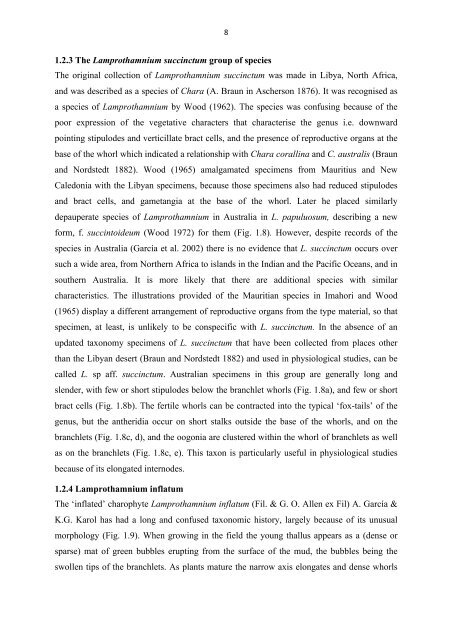Chapter 1: The Characeae Plant
Chapter 1: The Characeae Plant
Chapter 1: The Characeae Plant
You also want an ePaper? Increase the reach of your titles
YUMPU automatically turns print PDFs into web optimized ePapers that Google loves.
8 <br />
1.2.3 <strong>The</strong> Lamprothamnium succinctum group of species<br />
<strong>The</strong> original collection of Lamprothamnium succinctum was made in Libya, North Africa,<br />
and was described as a species of Chara (A. Braun in Ascherson 1876). It was recognised as<br />
a species of Lamprothamnium by Wood (1962). <strong>The</strong> species was confusing because of the<br />
poor expression of the vegetative characters that characterise the genus i.e. downward<br />
pointing stipulodes and verticillate bract cells, and the presence of reproductive organs at the<br />
base of the whorl which indicated a relationship with Chara corallina and C. australis (Braun<br />
and Nordstedt 1882). Wood (1965) amalgamated specimens from Mauritius and New<br />
Caledonia with the Libyan specimens, because those specimens also had reduced stipulodes<br />
and bract cells, and gametangia at the base of the whorl. Later he placed similarly<br />
depauperate species of Lamprothamnium in Australia in L. papuluosum, describing a new<br />
form, f. succintoideum (Wood 1972) for them (Fig. 1.8). However, despite records of the<br />
species in Australia (García et al. 2002) there is no evidence that L. succinctum occurs over<br />
such a wide area, from Northern Africa to islands in the Indian and the Pacific Oceans, and in<br />
southern Australia. It is more likely that there are additional species with similar<br />
characteristics. <strong>The</strong> illustrations provided of the Mauritian species in Imahori and Wood<br />
(1965) display a different arrangement of reproductive organs from the type material, so that<br />
specimen, at least, is unlikely to be conspecific with L. succinctum. In the absence of an<br />
updated taxonomy specimens of L. succinctum that have been collected from places other<br />
than the Libyan desert (Braun and Nordstedt 1882) and used in physiological studies, can be<br />
called L. sp aff. succinctum. Australian specimens in this group are generally long and<br />
slender, with few or short stipulodes below the branchlet whorls (Fig. 1.8a), and few or short<br />
bract cells (Fig. 1.8b). <strong>The</strong> fertile whorls can be contracted into the typical ‘fox-tails’ of the<br />
genus, but the antheridia occur on short stalks outside the base of the whorls, and on the<br />
branchlets (Fig. 1.8c, d), and the oogonia are clustered within the whorl of branchlets as well<br />
as on the branchlets (Fig. 1.8c, e). This taxon is particularly useful in physiological studies<br />
because of its elongated internodes.<br />
1.2.4 Lamprothamnium inflatum<br />
<strong>The</strong> ‘inflated’ charophyte Lamprothamnium inflatum (Fil. & G. O. Allen ex Fil) A. García &<br />
K.G. Karol has had a long and confused taxonomic history, largely because of its unusual<br />
morphology (Fig. 1.9). When growing in the field the young thallus appears as a (dense or<br />
sparse) mat of green bubbles erupting from the surface of the mud, the bubbles being the<br />
swollen tips of the branchlets. As plants mature the narrow axis elongates and dense whorls
















